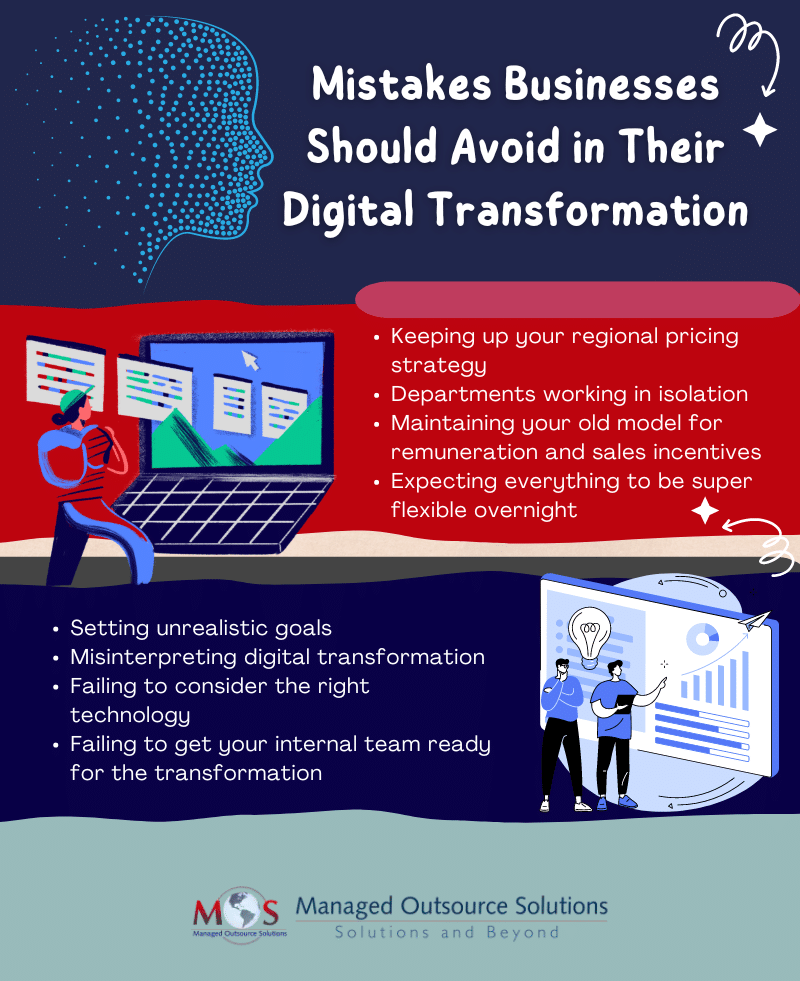In this era of digitization and business advancement, most organizations have big data initiatives. Digital transformation starts with digitizing paper-based data preferably with the support of a good provider of document scanning services. Transitioning to electronic data has changed the way companies interact with customers, employees and business partners. However, is this transformation being successfully implemented and executed?
As per McKinsey, around 70 percent of companies fail in their digital transformation process due to low or inadequate management, insufficient managerial support, low or nonexistent employee involvement, and a lack of responsibility. In other words, organizations are making huge investments in the latest technology as the first step towards digital transformation. However, owning the latest technology and machinery is not enough for digitization. The key elements for achieving successful digital transformation are a solid strategy, organizational culture and excellent leadership. The most challenging aspect of digital transformation performance is not deciding what to do, but rather how to actually do it.

What Can Go Wrong in the Digitization Journey?
Introducing a new system, and not adequately training and following up with employees: Most new strategies fail if employees are not adequately trained and followed up. Introducing something new, providing an initial training and then leaving employees alone with their potential questions is a wrong strategy. Constant follow-up is important for the entire process and all questions should be answered.
- Keeping up your regional pricing strategy: Statistics have shown that companies experience more sales abroad than at home. This results in total transparency of the buying and selling prices. This development should not be ignored.
- Departments working in isolation: Every department has its own set of rules but that alone is not enough. Proper communication among various departments is important to avoid any frustration or disappointment among the employees.
- Maintaining your old model for remuneration and sales incentives: There should be no postponing of adjusting employee incentives. When you demand that your employees change and put new ideas into practice, you should not on your part hesitate to adjust incentives. If new strategies offer positive results, then they should be rewarded accordingly. Employees should be recognized as well as rewarded financially when a new strategy succeeds.
- Expecting everything to be super flexible overnight: Digital transformation brings remarkable flexibility in everything – in-house project management, working hours, meetings and so on. However, when something new is introduced, top management should ensure that employees are well-advised on all the new changes and guided through the process. This is important to breed the desired corporate culture throughout the organization.
- Setting unrealistic goals: When embarking on a digital transformation journey, it is critical to set clear, attainable goals. Setting realistic expectations is essential for increasing revenue, reducing manual duties, and streamlining procedures. Digital transformation is a long process that takes time to align with the corporate strategy, and gaps cannot be resolved immediately. Define milestones and interim goals to evaluate progress and assess the impact over time. Patience is important, as digital transformation may take months or even years to fully become evident.
- Many businesses misinterpret digital transformation: Several businesses consider digital transformation as adopting a paperless system. However, it goes far beyond that. It involves leveraging digital technologies to modify business processes and culture to enhance customer experiences and adapting to changing market conditions. Rather than being a quick fix or a threat to jobs, digital transformation aims to improve how a business operates. To succeed, companies must strategically assess its future impact and integrate it into their current ecosystem. While adopting new technologies may change how and at what pace businesses work, it isn’t a solution to all problems but a tool to drive long-term growth and efficiency.
- Failing to consider the right technology: When businesses implement digital transformation projects, they often fail by focusing solely on the enabling technology. For example, if a company in a highly regulated industry adopts a video-first communication tool like Zoom or WebEx without considering compliance implications, the project may face delays. Companies should research the full technology stack in advance, ensuring they have the right security and compliance infrastructure and involving the necessary stakeholders.
- Failing to get your internal team ready for the transformation: Due to changes in work processes brought about by digital transformation, employees may experience anxiety and insecurity; studies show that over 80% of them expressed reservations about new technology. Although it’s normal, this aversion to change can be controlled. A culture of digital transformation should be promoted by the management, who should also encourage learning and offer in-depth instruction on new technologies and procedures. It’s critical to keep the lines of communication open and to convey the advantages to the staff. Finding early adopters on the team can also serve as a guide for others, which can improve morale and make the shift easier for all employees.
Primary Requirements
- Have a unique strategy: A proper strategy is the most important consideration, and ideally this strategy should be distinct from that of your competitors. The entire business model should be reviewed and adjusted to support the digital transition, and the strategy identified should be used to guide the transformation. Today, customers are spoilt for choice and have excellent control over their purchasing decision. They can compare products and also get reviews and recommendations with their social connections. So, companies should always keep in mind the idea of present-day empowered customers before they start the process of digitization. Only this approach can help them meet the specific needs of customers.
- A supportive work culture: The next consideration is an organizational culture that supports digital transformation. The benefits of such a transformation must be fostered in each and every employee and they must be eager to work towards it.
- Proper leadership is vital for any transformation: The CEO of an organization must be aware of the need for digital transition and encourage the team to try innovative ways of doing business and interacting with customers.
- Hiring experienced talent: A successful digital transformation requires skilled professionals with expertise in both technology and the specific industry. Hiring experienced talent ensures that the transformation is executed with knowledge, foresight, and adaptability.
- Managing new risks and opportunities: Digital transformation opens the doors to new opportunities but also comes with risks. Organizations must balance these, leveraging innovation while managing potential challenges like data security or compliance issues.
- Investing in the right technology: Choosing appropriate technologies is crucial. The tools should align with business goals, improve efficiency, and integrate seamlessly with existing systems. Proper investment ensures long-term benefits and avoids wasteful spending on ill-fitting solutions.
- Communication is vital: Clear communication throughout the digital transformation process is vital. Employees and stakeholders must understand the changes, their roles, and the benefits. Regular updates and open dialogue minimize resistance, ensuring smoother adoption and alignment across the organization.
Eva Janich of the Swiss consulting firm 4moreE pointed out some of these tips during her talk at the ISPO Academy at ISPO Munich 2018. Following are certain measures that will help deal with the risks posed by the modern business environment. They are:
- Think about your customers and be market-transparent. Flexibility should be the norm and keep adapting your model in keeping with new requirements.
- The IT department should be the best as they train your employees.
- Change the work culture, not the methods alone.
- Create international pricing models and manage the transparency of the prices.
- Adapt incentives and remuneration models, devise team goals and promote competition among the various departments.
- Think long-term and get digital natives on board.
- Always be honest, with your team as well as yourself
Digital transformation is the need of the day, and organizations needn’t be concerned about the large-volume paper-based data existing in their offices. These can be digitized and organized with bulk document scanning. Business leaders now realize that organizations must focus on bridging all their different channels, effectively maintaining organizational silos while embracing digital transformation. When a culture that supports the idea of the entire business functioning under one digital strategy is ensured, organizations can truly transform by going digital with the help of reliable document scanning services.




